Art Figurines of a Naked Woman Blindfolded and on Her Knees
ORIENTAL cults were ever familiar with the figure of the nude adult female, the "funeral Venus," whose images are found in all the cemeteries of the one-time globe. Local worship does not always explain its origin and grapheme. Nigh of these images are dirt figurines. The small collection of stone statuettes and carvings in bone which is dealt with here is treated separately because it is made of different material, and considering it belongs to a late Graaco-Parthian period. Most of the figurines were discovered in tombs at Jumjuma, a small village near the ruins of Babylon. Like the terra-cottas, they have a funerary purpose, and they disclose a marked predilection for the nude female effigy. Dirt figurines always had a shut connectedness with faith, and entire nudity e'er has a mythological meaning. Their common character is the place they occupy in funeral rites, and the symbolical expression they give to coarse but positive ideas on futurity life.
The nude dear-goddess was a dominant and pop figure in Babylonia long before Praxiteles introduced the nude Venus to the assembled Greeks. The nude mother-goddess, holding and suckling an baby, is a familiar blazon in the old Sumero-Babylonian religion, nether different names—Innina, Nana, Ishtar, Bêlit, Zarpanit, or Allat. But it is hard to decide whether these little figurines found in cemeteries have a close connection with the local cult, or—which is more probable—whether they have a larger significance in relation to the religious and funerary concepts of the whole country; whether the local idol is the glorification of the ancient nude female person effigy, or the latter a copy of an idol.
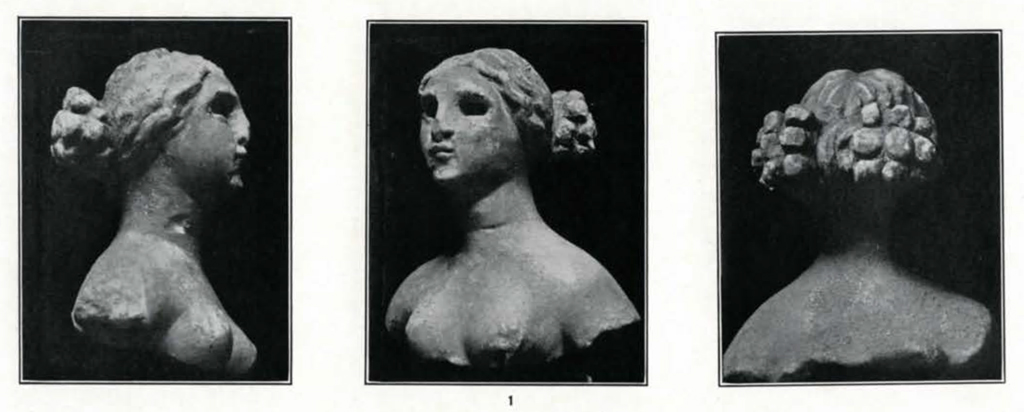
In whatsoever instance they embody the idea, transmitted to u.s. by Herodotus, of Mylitta the Assyrian Aphrodite, the goddess of sacred prostitution in Babylon, of Anaitis or Anat, the protective deity of Warka. Her cult was adopted by the Persians, especially past Artaxerxes Ii Mnemon, who ordained the erection of her statues through out the empire. The Greeks in their plough received her as Aphrodite or Artemis, non dissimilar the many breasted Diana of Ephesus. Susa in Elam had her oriental Diana called Nannaia in the Greek text of the Bible and Anahata in a local Persian inscription. Berosus mentions Susa equally one of the cities in which Artaxerxes ordered the erection of a statue of Anaïtis.
There is a marked advance in the course and inspiration of these little nude figurines, which is due to the influence of Greek art and mythology after Alexander, but at that place is no complete transformation, no deep amending in the cult and rites. The ancient local taste survives in the choice of symbols, dresses, and a deep note of sensuality.
The best book on the subject field is nevertheless the catalogue of Figures Antiques de terre cuite du Musée du Louvre, by 50. Heuzey, from whom we borrow many of the following notes. The Greek influence in Babylonia was attenuated by its fusion with older oriental elements. For clay figurines the Greek artists substituted alabaster, which is more refined, with a touch of affected elegance, while the clay figurines are coarser and their makers more preoccupied with symbolism in the beginning place. The Greek influence connected nether the dominion of the Parthian kings. The river Euphrates was the existent frontier between the Roman and the Western farsi empires.

While Babylonia did not remain for fifty-fifty a century under Greek domination, history accounts very well for this partial but persistent intrusion of Western elements in the East, and the remarkable vitality of the cultural centres founded by invading Hellenism before and after Alexander. When the Roman power was at its highest, on the extreme border of the Roman province of Asia, Samosate on the Euphrates, the native city of the Atticist Lucian, had sculptors who kept the best traditions of Greek art alive on the frontiers of the Parthian country. Palmyra, late in the third century A.D., welcomed both Greek and Aramaean culture.. Under the Parthian kings, the slap-up city of Seleucia on the Tigris, heir to the destroyed urban center of Babylon, rich and prosperous with over six hundred thousand inhabitants, ever preserved its autonomy. For the younger Pliny, it was still a Greek metropolis with a Macedonian constitution, libera hodie, air-conditioning sui juris, Macedonumque moris.
In order to avert direct contact between the Parthian troops and the large Greek population, the Parthian kings had established their courtroom at Ctesiphon on the other bank of the Tigris. Far from being opposed to Greek civilisation, they took keen care of the numerous Greek or Levantine communities imbued with Greek spirit in their empire. On their coins they acquit the title Philhellene. The kings of Characene who in the days of Augustus ruled over lower Mesopotamia down to the Persian Gulf, stamped their names in Greek characters on their coins, and in Greek and Aramaic on one of their bricks preserved in this MUSEUM.
Co-ordinate to a report of P. Delaporte, in 1863, of excavations at Hillah nearly Babylon, a vaulted sepulchral room was institute, including six tombs tending in parallel order. The bricks employed in the structure bore the stamp of Nebuchadnezzar, showing that the vault was posterior to the destruction of Babylon. Masks, clay cones, and statuettes were discovered within. Each tomb had a statuette placed near the head of each corpse, except in the first tomb, that of a man. These were alabaster figurines respective to a class of Graeco-Babylonian clay figurines, of which they are perfected and richer copies. The relation between the funerary masks and the figure, historic period, and sex of the deceased is very doubtful, but they all seem to have been of local manufacture and to have had a funerary purpose, in which they confirm the conclusion of Loftus and Layard.
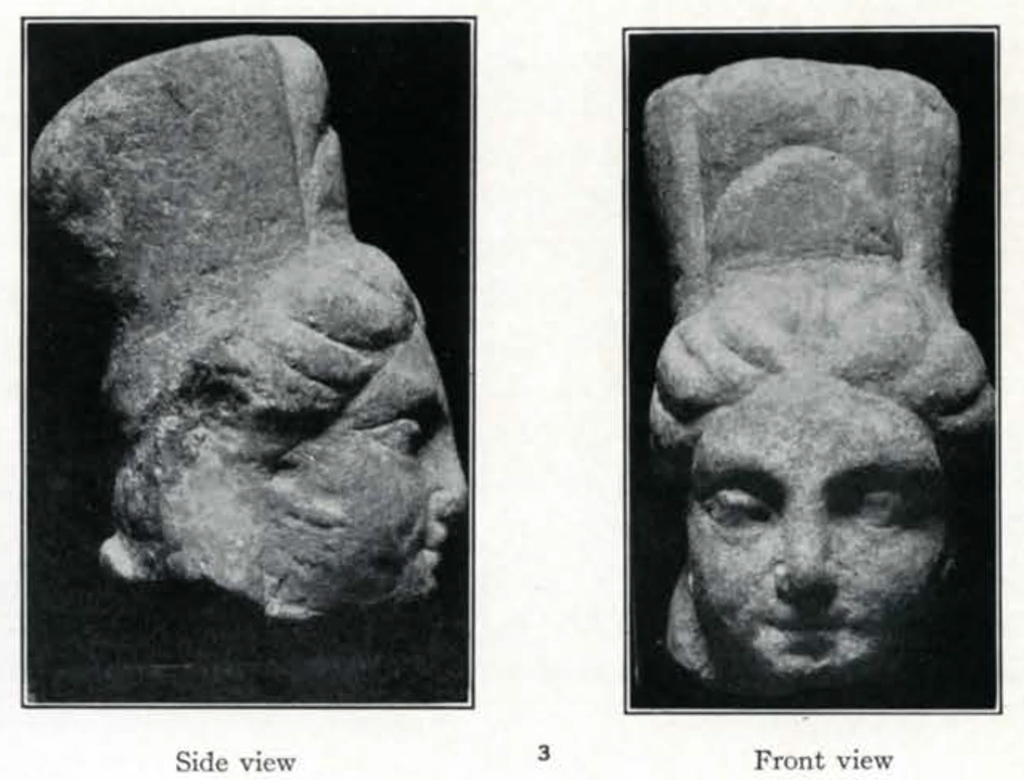
Museum Object Number: B9365
Paradigm Number: 8038
Loftus's Travels and Researches in Chaldea and Susiana though over half a century erstwhile, is however i of the classics of Babylonian archeology, and his description of the burials at Warka in Graeco-Parthian times is worthy of conscientious reading, pp. 210, ff.
"Many small objects are associated with the—slipper shaped—coffins, either in the inside or effectually them in the world or vault. The personal relics of the deceased consist of golden and argent finger-rings; armlets, bangles and toe-rings of silver, brass and copper; bead-necklaces and modest cylinders. Gilded ornaments are not uncommon, such as ear-rings, and minor plates or chaplet for fillets, of tasteful and elegant pattern. Thin gold foliage sometimes appears to have covered the confront similar a veil; and i or two broad ribbons of sparse gold not infrequently occur on each side of the head. Large pointed head-dresses, Budda—one of the workmen—told me, had been found and sold to the perambulating Jews who visit the Madan periodically for the purpose of purchasing the gold.
"With the in a higher place are articles of a different description such every bit small-scale earthen drinking vessels and lamps, glass lachrymatories, copper bowls, hideous os figures, probably dolls, and a variety of others.
"The height of the bury is oft a receptacle for small relics—apparently the parting gifts of friends—as the following list volition testify:—seven different forms of frail coloured glass bottles, two curiously formed yellow drinking glass dishes, a glass terracotta lamp (a abiding accompaniment), 4 os stilettos, two atomic number 26 implements, the bones of a small bird, fragments of a bunch of flowers, and an ornamental reed basket (the plaits of the reeds being quite singled-out) containing 2 pieces of khol or black pigment for the eyelids, and a tassel bead. Judging from their character, these articles appear to have been the property of a female.
"Strewed in the earth effectually the coffins are numerous copper coins, the only articles which afford whatever positive clue to their age. . . The types are extremely indistinct, but no doubtfulness is entertained of their existence Parthian. Close to the foot of each coffin are ane or more large glazed water-jugs and earthen drinking cups, of extremely creative form. One . . . tall jug was constitute in a recess congenital for its reception in the side wall of the vault, within arm's length of the coffin. The bones of a fowl with a flint and steel were also frequently deposited upon the lid. The practise of placing food and h2o near the body was certainly continued with the superstitions of the period. The same practise is, I believe, continued among the Arabs, who conceive that these articles are necessary to give the spirit strength on its long journey.
"Some of the most interesting objects found in the same position are pocket-sized terra-cotta figurines, which were probably household divinities. Many are undoubtedly Parthian; such, for instance, equally the reclining warrior, with a loving cup (?) in his left hand, wearing a coat of mail or a padded tunic reaching to the knees and a helmet ornamented in front. The whole costume is well represented on many coins of the Parthian epoch.

Museum Object Number: B318
Image Number: 8015-8017
"Several are female figures in loose attire exhibiting strange headdresses, which, doubtless, give us some notion of the costume of the menstruum. One of these is very remarkable; it rises into ii alpine conical peaks, from which depends a veil, reminding i strongly of the English ladies' costume in the time of Henry Iv. Nude female figures, probably representing the Mylitta or Venus of the Assyrians, were extremely common at the Parthian menstruation, having been handed down from antiquity. Like figures are universal throughout the Due east before the Christian era. A few figures carry traces of colour."
Some clay heads "are most interesting. They are infinitely superior to the rest in bespeak of blueprint and execution and marker the rapidly spreading influence of Greek art. They possess all the feature features and boldness of the Greek face and withal they tin scarcely exist other than the works of Babylonian artists. The hair is arranged in long ringlets and the heads are surmounted past lofty headdresses of different form.
"Information technology would exist endless to give in detail all the small articles which were discovered in connection with the slipper coffins."
Clay, bone, or alabaster dolls were plant in tombs of Hillah. They are nude figurines, with legs close together, and no base to stand up upon. Their shoulders are bored through to attach a mobile arm. The utilize of dolls or articulated figures has a complex signification both religious and magic, as being an imitation of life. The same observation applies to all dirt figures and to images in general.
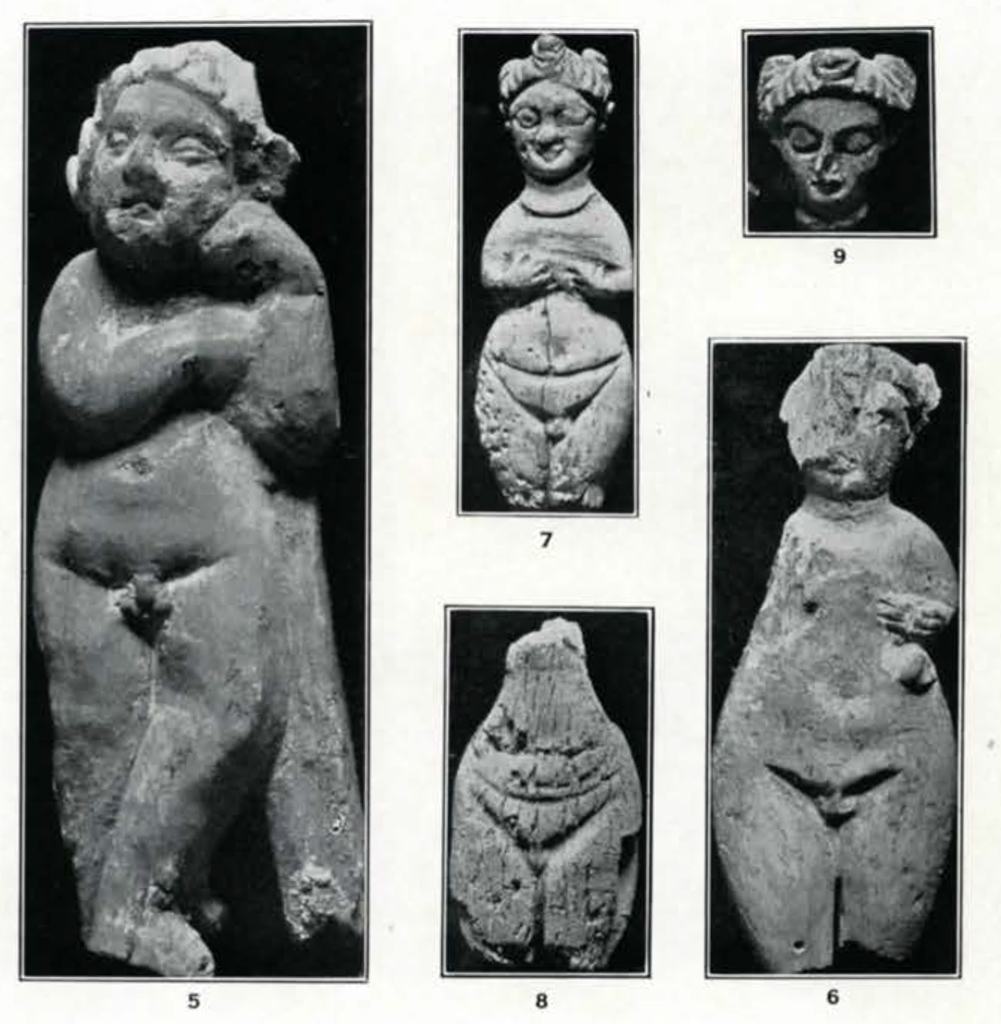
Museum Object Number: B6180A / B14386
Some alabaster dolls take a hieratic attitude. Their correct arm is bent forward, the paw open, as if set up to receive the offering. The prettiest were covered with gilded ornaments, and had semiprecious stones inlaid in the eye sockets and navel, to add life and colour to their voluptuous nudity. Clay dolls have only masses of hair confined by a turban adorned with studs. They are a inexpensive reproduction of the better models, merely their symbolism is the aforementioned. Virtually all bear witness traces of a stucco blanket in fake of alabaster. On the white slip details were worked out with the point, and saliences of the torso were accentuated in pink, marking the ribs, the folds of flesh, the sex activity, and the partitioning of the legs. Several dolls with fixed arms copy the traditional mental attitude of the antique Venus, arranging the hair with one hand, and covering the breast with the other..
Funerary dolls are the direct descendants of the older Farsi and Babylonian nude figures of Anaitis, Ishtar, Innina, or other forms of the goddess of honey. She was long pop with the Parthian, and is yet reproduced every bit the "angelic goddess" on the coins of Musa, the mother of Phraates, in the kickoff century.
Other figurines establish at Hillah show women lying on a couch, resting on an elbow in the mental attitude of the guest at a banquet. They wearable a high peaked cap, not unlike the Phrygian cap adopted by Greek art as the proper headdress of mythological beings, specially of those from Eastern regions. The cap in the alabaster figures is sometimes gilded, or the hair is uncovered and tied on the top of the head in a bow after the fashion of Venus and other immature goddesses of the Western Olympus. Some figures are entirely nude, or draped only almost the lower limbs with a tight-plumbing equipment shawl, as is common in the Greek representations of Venus. They normally lean on a cushion, and the bed with its iv legs is sometimes represented in terracotta reliefs. The figure of the deceased dressed in his best garments and resting on a couch like a guest at an eternal banquet is familiar throughout antiquity. The gods also were treated to sacred banquets and their statues placed on ceremonial beds on solemn festival days. On the pinnacle of the stage tower of Babylon, there was an empty shrine containing only a table and a magnificent bed on which the god Marduk was supposed to have his remainder at nighttime while visiting the high priestess.
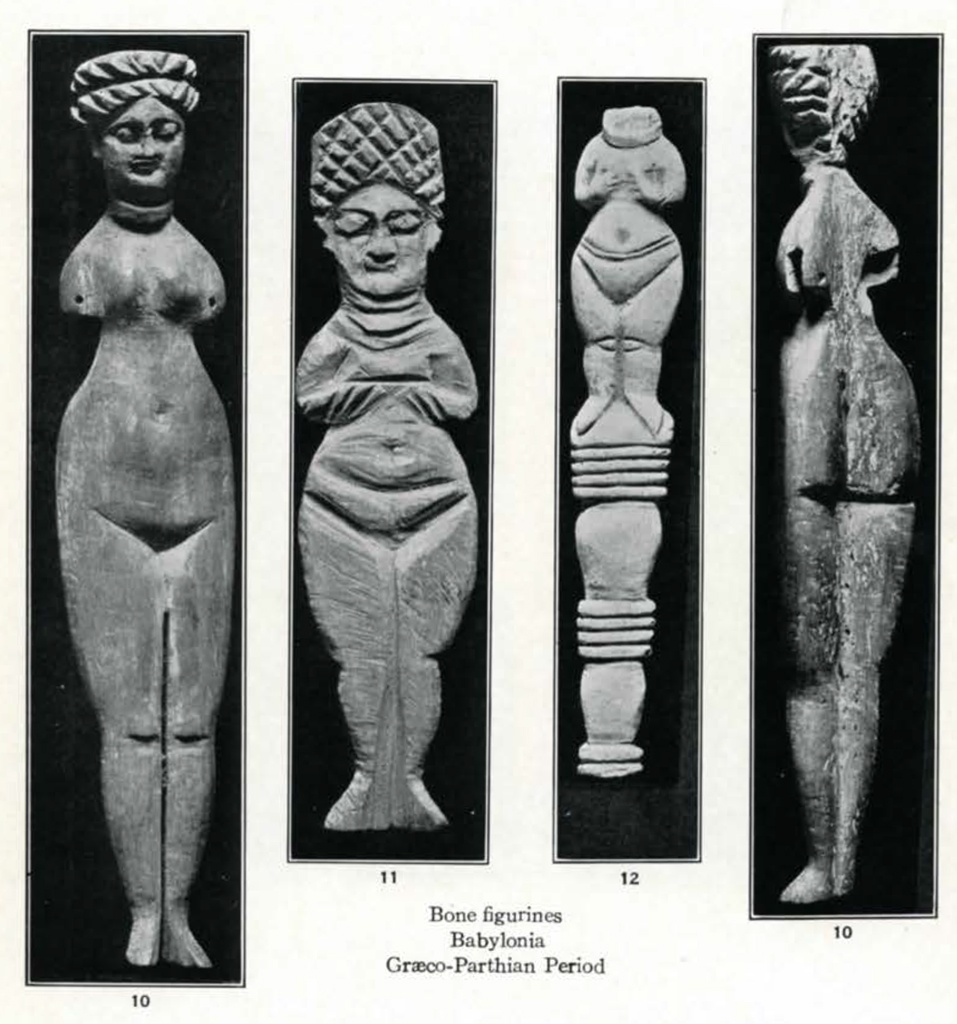
Museum Object Numbers: B8997 / B9026 / B5984A
We may therefore consider these nude alabaster figures which in the late period were placed near the caput of the expressionless equally so many funeral goddesses, i a love goddess, the other a female parent goddess, co-ordinate to an ancient Babylonian tradition modified by Greek custom, which through a mythological interpretation saw the spirit of the expressionless absorbed into their divinity.
The aforementioned must be said of alabaster children'southward figures found in tombs at Hillah. A nude male child is represented sitting on a minor bench, his left leg folded under him. A stucco headdress is added, having two golden bullae similar the berries on the ivy crown of Bacchus. He grasps with both hands a pine cone or a grape at which a bird is pecking, or which a snake tries to bite. He may accept wings like Eros, and his headdress has three points or rays, which may represent curls of hair, or through a fusion of symbols in a late menstruum may combine a peaked cap with ivy leaves. Sometimes it is only a hollow bust with a loose clay ball within, both a funerary amulet and a rattle.
The connection of the child with folded legs with the images of the immature Horus in Egypt and with the other infant gods similar Bacchus, Athys, Adonis, was established long ago. In Carthage he holds in his hands the dove of love. In Babylon he was Tammuz, the newly born god of love, whom Ishtar brings back from Hades.
Funerary golden masks found in Nineveh, in Syrian arab republic, in Hillah, and in Nippur are not unlike the masks the Egyptians used to place on the confront of the mummies. They preserve the likeness of the expressionless when his flesh has decayed, and afford an abode for his spirit. Masks with a hole for suspension, too found in tombs, some representing disguised and smile faces, some graceful girls or children, or fifty-fifty animals, were protective emblems, with some of the virtues of the original mysteriously attached to them.
The nude figurines and the dolls of the Graeco-Parthian menstruum, abundant in tombs, have more perfection and elegance, merely also a boiler due to the lack of inspiration in epochs of decadence. Their sex is indicated with the reserve usual in Greece but remote from the erstwhile Babylonian realism.
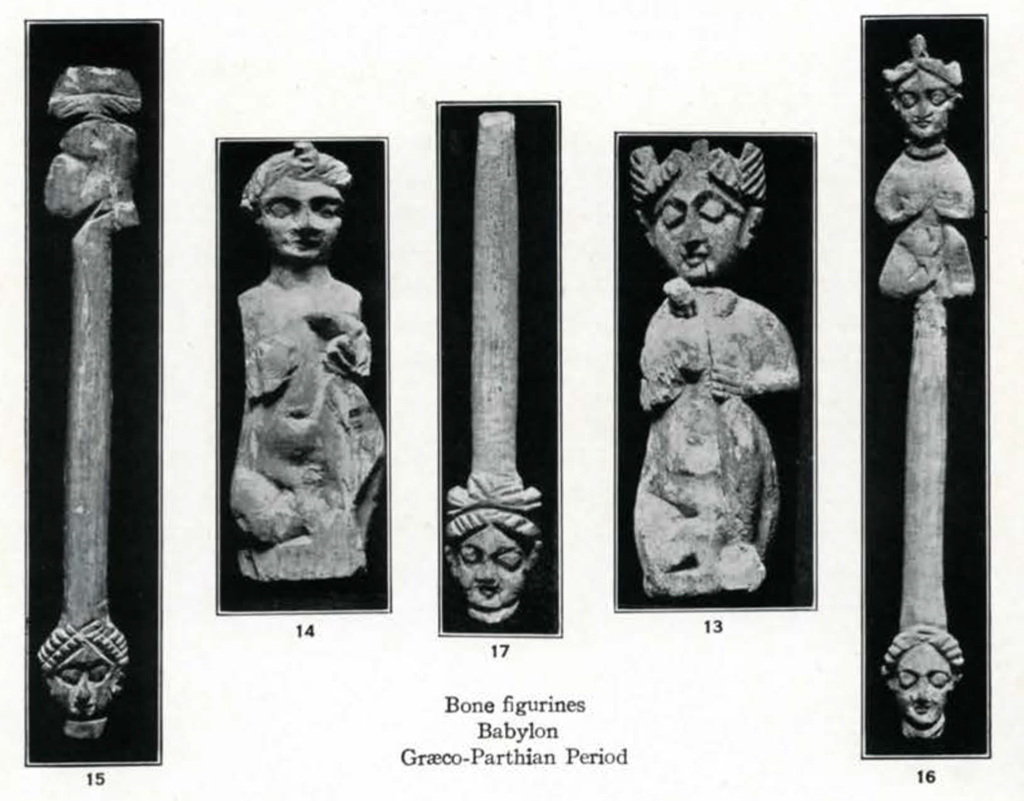
Museum Object Numbers: B2539 / B1777 / B4030 / B14636
There are several types of the nude Babylonian woman. 1 keeps her easily joined earlier her in a respectful, passive mental attitude. The other has them slightly raised, supporting or pressing her breasts. She is undoubtedly the servant of love, presenting herself—stat nuda. This is as well one of the attributes of Ishtar, the sacred prostitute of the gods. In both cases she stands upward adorned only with her jewels, the locks of her pilus falling on her shoulders. Sexual activity and navel are clearly indicated, the pubes being a large triangular patch bordered by incised lines inclosing markings. This is also the pictograph for woman in the cuneiform writing from the primeval times. Nosotros must therefore run across in these figurines an image of life, an emblem of fruitfulness, in connection with the idea of perfect womanhood. They are conformed to the most primitive instinct of human being, and respond to the very name given by Adam in paradise to Eve, when both were naked and unashamed.
Afterward, the nude female person figure was more closely associated with the divinity. It is raised on a base of operations and must have been an object of cult. The goddess of love is borne on an animal—usually the lion—pressing her breasts or unveiling herself, and it is difficult not to recognize a nude goddess. Simply the magical and symbolical character of the nude woman equally a token of life, an emblem of fruitfulness, and, in the tomb, as a protest against decay and an emblem of resurrection, has a large human interest that cannot be limited to the reproduction of 1 type of idol. The nude female person effigy with its secret and talismanic grapheme existed long before it was transformed into the dear goddess and made an object of cult. Far from being all images of Ishtar, the nude figurines were her model.
As a rule human representations of the gods are relatively contempo. A symbol, creature, weapon, or raised rock, was at commencement the all-sufficient object of cult, marking the presence of the superhuman ability. The oldest shrine of the beloved goddess may have enclosed a betyl, with perhaps a triangle incised on the surface. In the Nippur drove of terracottas there is at least ane fragment—CBS. 15426—on record every bit being plant fifteen feet below the level of Naram-Sin, and therefore anterior to B.C. 3000. It bears the triangular patch, with interior markings and traces of red colour. The rude figurine when complete was perhaps a votive offering for childbirth, or, at the time of puberty, a substitute for herself fabricated by a Sumerian votary to the shrine; but information technology can scarcely be called an idol or an prototype of the love goddess, since probably in these early days at that place was no prototype of the goddess.
On seal cylinders the figure of the nude woman belongings her breasts is not establish long before B.C. 2000, precisely when the Western Amorite influence began to exist preponderant in Babylonia. Northern Syria is known equally the home of the keen mother goddess, the nude goddess unveiling herself. But on the Babylonian seals, the nude figure is always an accessory person, drawn on a modest calibration, and taking no interest in the master scene of worship. She tin can in no way compare with the older gods of Babylonia, who never go about nude, only are kings and queens, and never forget their mitre adorned with one or 4 pairs of horns, by which they are distinguished from any human being. They behave also a sceptre and wear rings, carry various weapons, and are clad in the finest royal garments. The only nude royal figure is that of Gilgamesh, a hero and a king, simply he never wears the divine horns. At the utmost a little base of bricks which is sometimes placed under the feet of the nude female effigy may advise her transformation into an idol.
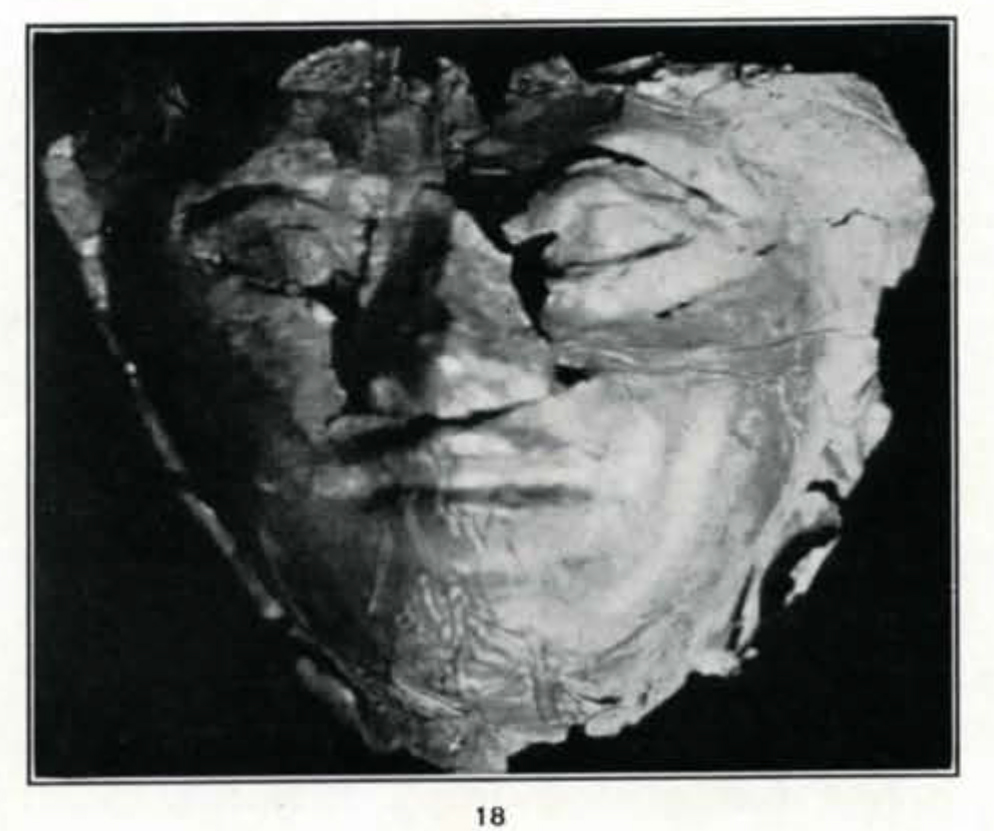
Image Number: 5997, 10302
Ishtar, as a goddess non of love, but of war, is fully dressed and armed, and is represented on seal cylinders and rock reliefs in authentic portraits long before the nude love goddess. She wears a shawl tied about her waist, falling to the ankles, and opening in forepart to give play to her bare leg in action. Higher up the human knee is seen the lower edge of a short tunic or cuirass which has curt sleeves. Quivers full of arrows and darts are crossed on her shoulders. She wields battleaxe and scimitar. As a remnant of feminine vanity, she wears beneath the horned mitre her long curls falling on her shoulders, while more matronly deities tie them upwardly in a knot on the cervix.
There is some other Ishtar of the legend, the queen of love, who very much resembles our nude figurines, as she goes downward to Hades in quest of her dead lover. At each of the seven gates she drops in turn i of her ornaments : tiara, earrings, necklace, breastplate, chugalug, bracelets, and anklets, until she has left just her loin cloth, which besides she must discard before entering Hades. We practice non know how far back the legend tin be traced. Rock monuments and clay figurines requite no evidence of information technology before B.C. 2000. Its connection with burials has certainly its deepest and most poetical expression in the myth of Ishtar and Tammuz.
"That which thou sowest, is non quickened, except it dice."
In that location are other figures of a nude adult female as a nurse, holding or suckling a child. One of the nigh beautiful types may fifty-fifty be dated at about B.C. 2400. Simply it is impossible to show that we have in it a reproduction of any famous idol, similar the mother goddess of Warka. These figures have been plant throughout Babylonia and take nil by which to place them aside from their pure and beautiful humanity. Another example of the nursing female parent is completely dressed in a long flounced robe, with her hair simply tied by a fillet. A nude female figure pressing her breasts is represented on a terracotta from Nippur as lying on her dorsum on a low bed. In an example in the Yale Collection the bed is covered with a carpet. A couple lying on a bed is seen on a terracotta of the British Museum. These nude figures are very human, and their symbolical and religious significant does non transform them into idols. Archaeological truth is the result of a series of observations and comparisons between a big number of examples, and it cannot be anticipated.
- Alabaster statuette. A nude female figure of the virtually mannerly grace and beautifully modelled. Arms and body are unfortunately broken off below the breasts. The head is slightly inclined, the neck with its 2 folds in forepart, the shoulders and shoulder blades, and the business firm circular breasts are cut out of the luscious alabaster by a masterly hand with a vivid sense of life, in the all-time tradition of Greek art. The large optics were originally inlaid with precious stones and must accept added a new lite to the beautiful though rather curt and round confront. The nose is almost direct, but its tip has been cleaved off. The hair is parted and waved and tied on the nape of the cervix in two large masses of short curls later the fashion of the Roman ladies of the first century. If at that place were any gold ornaments, they have disappeared and left the statuette in its simple and delightful grace as it came from the hands of the sculptor.
CBS. 3988. Presented to the first Nippur Expedition in 1889 past Mr. Coleman, engineer, equally coming from Babylon. sixty X 34 mm. - Nude figure of a immature goddess. With one mitt she is covering her breast. The other was probably held in the traditional attitude of the Greek Venus, represented on terracotta reliefs decorating slipper shaped coffins of the Græco-Parthian menstruation. Unfortunately the right arm and the lower part of the body are broken off. The hair is parted and waved and falls in long tresses on the shoulders. It is too tied in a bow above the caput after the style of other young goddesses. One shoulder is slightly depressed, conveying a feeling of action and life unknown in the older hieratic statuettes of Babylonia.
CBS. 9368. Bought by J. Haynes in North Syria before 1899. White marble. 125 X 84 mm. - White marble caput of a young goddess, of the Greco-Parthian catamenia. Above her parted and waved hair she wears a loftier mitre or calathos adorned in front with a semicircle between straight lines which probably stand for a metal ring.
CBS. 9365. Bought past J. Haynes in North Syria before 1899. 80 X 48 mm. - Nude female effigy reclining on a bed. The lower limbs are partly covered with a sparse drapery. The other stop of the same long veil or scarf is thrown over the left arm and the lite fluffy cloth sets off by dissimilarity the complete nudity of the adult female. She is another Venus resting confident in the triumph of her perfect beauty. The arms were worked separately and fastened. The right arm
- Fragment of a little bone figurine like the higher up.
CBS. 6180. Probably brought by H. 5. Hilprecht from Hillah
in 1889, merely unregistered. 37 X 20 mm. - Piddling bone caput of a like figurine.
CBS. 14386. Unregistered. 20 X 17 mm. - Nude female figure, wearing merely a necklace and having her hair plaited and crossed past a fillet. This is a bone figurine with split up arms attached by a wire through the shoulders. The pubes and navel, minor breasts and big hips, the feet and knee caps are carefully modelled and accentuated. In that location is in the figure a smoothness and elegance proper to Greek art. This little figure was probably not used as a doll, merely is a new grade of funerary Ishtar, the triumphant symbol of life cached with the dead.
CBS. 8997. Brought probably from Babylon by the second Nippur expedition. 124 X 25 mm. - Bone doll. Nude female effigy as before, but of much coarser workmanship. The artillery are not separate. The hands are placed under the breasts. A high calathos seems to cover the head.
CBS. 9026. Brought probably from Babylon by the 2d Nippur expedition. 95 Ten 25 mm. - Same effigy every bit before, merely mounted on a shaft decorated with rings, and wrongly called a hairpin. The long point was used to set information technology in the clothing of the dead or in the basis.
CBS. 5984. Cast. Original missing. Unregistered; but probably found in Babylon. 88 Ten fifteen mm. - Trivial nude figure as above (Nos. half dozen to nine), but seated with the left knee drawn up and the right leg aptitude under; same confusion of sex; aforementioned headdress with three points, and left hand holding the breast or an undefined object. The figure probably represents the young Tammuz, comparable with Horus or Adonis. Bone (or ivory) carving.
CBS. 2539. Brought back past the second Nippur trek. Probably bought in Hillah by H. V. Hilprecht, like the following number. 40 X 20 mm. - Little nude bone (or ivory) figure of a seated boy similar the above.
CBS. 1777. Brought back by H. V. Hilprecht in 1889. 58 Ten 20 mm. - Little nude os figure seated as before, but connected by a long shaft with the head of what must have been a nude female figure. This would consummate the wheel of the legend, combining the ii persons of Ishtar and Tammuz.
CBS. 14636. Unregistered. Probably constitute in Babylon. 89 X 11 mm. - Head of Ishtar, long shaft and seated nude boy as earlier.
CBS. 4030. Bought by the first (?) Nippur expedition. 85 10 11 mm. - Same object as above. Only the head of Ishtar and the shaft are preserved.
CBS. 323. Bought from J. Shemtob in London, in 1888. 66 X 12 mm. - Mask made of sparse gold leaf, and probably institute in a
Parthian tomb past the 4th Nippur expedition.
Known only from a photograph, No. 215, taken in the field.
Source: https://www.penn.museum/sites/journal/9120/
0 Response to "Art Figurines of a Naked Woman Blindfolded and on Her Knees"
Post a Comment